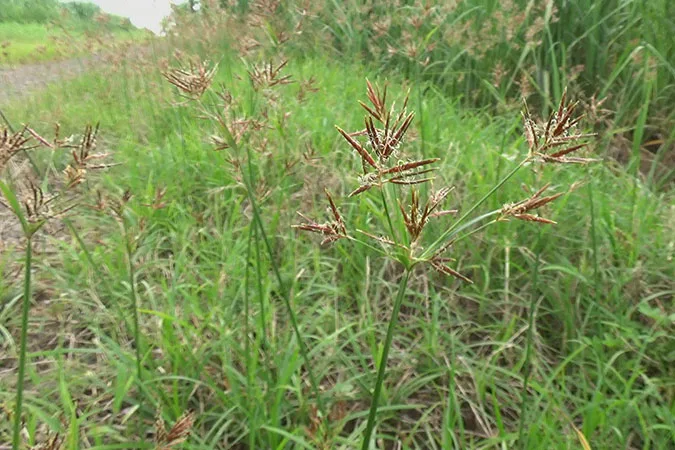Teki or purple nutsedge (Cyperus rotundus) is a species of plant in the Cyperaceae, an erect annual growing to a height of up to 140 cm, the leaves sprout in rows of three from the base to a length of 5-20 cm, ribbon-shaped, pointed tip and green in color.
The inflorescence has a stalk with a triangular cross section and is green. The inflorescence has three to eight unequal spikes. The flower is bisexual, has 3 stamina and the pistil has three stigmas. The fruit is achene and triangular.
The initial stage forms a white fleshy rhizome, 25 mm long and in chains. Some of the rhizomes grow upright above the ground, then form a tuber-like structure from which new shoots and roots grow, new roots and new rhizomes grow. Other rhizomes grow horizontally or downward and form reddish-brown tubers or tuber chains.
Teki prefers dry places, but will tolerate moist soil and often grows in wastelands and in crop fields. Tubers are an important source of nutrition for migratory cranes. Source of carbohydrates in the tropics in times of famine.
Kingdom: Plantae
Phylum: Tracheophyta
Subphylum: Angiospermae
Class: Liliopsida
Order: Poales
Family: Cyperaceae
Subfamily: Cyperoideae
Tribe: Cypereae
Genus: Cyperus
Species: Cyperus rotundus
Subspecies: Cyperus rotundus ssp. rotundus
The inflorescence has a stalk with a triangular cross section and is green. The inflorescence has three to eight unequal spikes. The flower is bisexual, has 3 stamina and the pistil has three stigmas. The fruit is achene and triangular.
The initial stage forms a white fleshy rhizome, 25 mm long and in chains. Some of the rhizomes grow upright above the ground, then form a tuber-like structure from which new shoots and roots grow, new roots and new rhizomes grow. Other rhizomes grow horizontally or downward and form reddish-brown tubers or tuber chains.
Teki prefers dry places, but will tolerate moist soil and often grows in wastelands and in crop fields. Tubers are an important source of nutrition for migratory cranes. Source of carbohydrates in the tropics in times of famine.
Kingdom: Plantae
Phylum: Tracheophyta
Subphylum: Angiospermae
Class: Liliopsida
Order: Poales
Family: Cyperaceae
Subfamily: Cyperoideae
Tribe: Cypereae
Genus: Cyperus
Species: Cyperus rotundus
Subspecies: Cyperus rotundus ssp. rotundus
